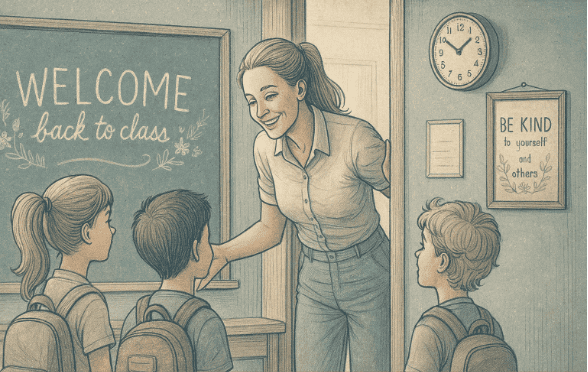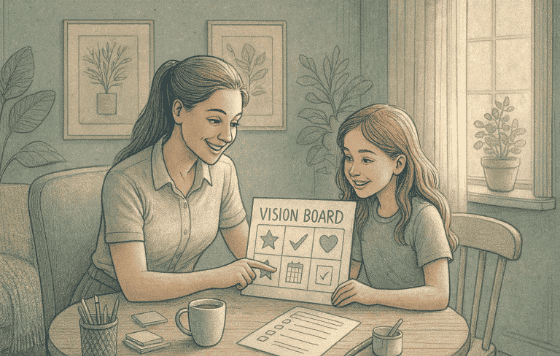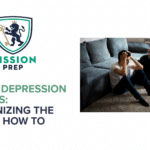Key Takeaways
- Teachers are in a unique position to recognize signs of depression early, since they see students daily and can notice shifts in behavior, participation, and academic performance.
- Building trust and emotional safety in the classroom creates a strong foundation for support, helping students feel valued, understood, and less isolated in their struggles.
- Focusing on strengths and celebrating small wins counteracts negative self-perceptions, giving students confidence and motivation to keep moving forward.
- Teachers can maintain hope and guide students toward professional help when needed, ensuring early intervention while continuing to provide consistent encouragement and classroom support.
- Mission Prep’s school-based programs help teachers and students work together to address depression through therapeutic approaches
Recognizing Depression in the Classroom
Teachers spend more waking hours with students than most parents do, making them uniquely positioned to notice when something isn’t right. Depression in students doesn’t always look like sadness or tears. It often appears as sudden drops in academic performance, increased absences, social withdrawal, or changes in behavior that seem out of character.
You might notice a previously engaged student becoming increasingly quiet, turning in incomplete assignments, or seeming disconnected during class discussions. Some students with depression become irritable or restless, while others appear constantly tired or overwhelmed by tasks they used to handle easily.
The classroom environment offers teachers valuable insights into students’ emotional well-being through daily interactions, group dynamics, and academic patterns that parents might not see. This unique perspective makes teachers essential partners in supporting students who may be struggling with depression.
Mission Prep Healthcare specializes in mental health treatment for teens aged 12-17, offering residential and outpatient programs for anxiety, depression, trauma, and mood disorders. Our therapies include CBT, DBT, EMDR, and TMS, tailored to each adolescent’s needs.
With a structured, supportive environment, we integrate academic support and family involvement to promote lasting recovery. Our goal is to help teens build resilience and regain confidence in their future.
How Can Teachers Help Students with Depression?
Strategy 1: Build Genuine Connection and Trust

Building authentic relationships with students creates the foundation for all other supportive interventions.
The foundation of supporting any student, especially those dealing with depression, is establishing genuine connection. Students need to feel seen, valued, and understood before they’ll accept help or open up about their struggles.
Start by learning each student’s name and using it regularly. Make eye contact during conversations and show interest in their thoughts and experiences beyond academic performance. Simple gestures like asking about their weekend, remembering details they’ve shared, or acknowledging their efforts can build significant trust over time.
Create opportunities for one-on-one interactions, even brief ones. This might happen during independent work time, before class starts, or during transitions. These moments allow you to check in personally and notice changes in mood or energy that might signal depression.
Listen without immediately trying to fix or solve their problems. Sometimes, students need to feel heard more than they need advice. Reflect back what you’re hearing: “It sounds like you’re feeling really overwhelmed right now” helps students feel understood and validated.
Consistency in your interactions builds trust. When students know they can expect the same supportive, non-judgmental response from you, they’re more likely to share when they’re struggling.
Strategy 2: Create Emotionally Safe Learning Environments
Students with depression often feel vulnerable and may struggle with concentration, memory, or emotional regulation. Modifying your classroom environment and teaching approaches can provide the support they need to stay engaged in learning.
Establish clear, predictable routines that reduce anxiety and help students feel secure. When students know what to expect, it removes one source of stress from their day. Post daily schedules, use consistent signals for transitions, and maintain regular classroom procedures.
Offer flexible seating options or quiet spaces where students can retreat when feeling overwhelmed. This might be a reading corner with comfortable seating or permission to step outside the classroom briefly when needed. Having these options available prevents situations from escalating and gives students tools for self-regulation.
Adjust assignment expectations when necessary without lowering standards. This might mean offering extended deadlines, breaking large projects into smaller steps, or providing alternative ways to demonstrate understanding. The goal is removing barriers to learning, not reducing academic rigor.
Create classroom norms that promote emotional safety for all students. This includes zero tolerance for bullying, encouraging supportive peer interactions, and teaching the whole class about empathy and inclusion.
Strategy 3: Focus on Strengths and Small Wins
Depression often creates a negative lens through which students view themselves and their abilities. Teachers can help counter this by consistently highlighting strengths, celebrating progress, and creating opportunities for success.
Notice and acknowledge effort, not just results. Comments like “I can see how much thought you put into this response” or “You showed real persistence working through that difficult problem” help students recognize their own capabilities and build confidence.
Break larger tasks into smaller, manageable steps that allow for frequent success experiences. Instead of assigning a month-long research project, create weekly milestones that students can complete and feel accomplished about. Each small win builds momentum for the next step.
Identify each student’s unique strengths and create opportunities for them to shine. Maybe one student excels at helping others, another has creative problem-solving skills, or someone shows leadership potential. Deliberately creating situations where students can use their strengths helps them see themselves more positively.
Keep private records of positive observations about each student so you can refer back to specific examples when they need encouragement. Having concrete examples ready makes your positive feedback feel more genuine and meaningful to students.
Strategy 4: Maintain Hope and Encourage Help-Seeking

Teachers who maintain hopeful, encouraging attitudes help students believe that their current struggles are temporary and manageable.
Students with depression often feel hopeless and may believe their situation won’t improve. Teachers can serve as important sources of hope and encouragement while also connecting students with additional support resources.
Share stories of resilience and growth, both from your own experience and from books, history, or current events. Help students understand that difficult periods are temporary and that people can learn to manage challenging emotions and circumstances.
Normalize seeking help and talking about mental health. When appropriate, share how counseling, therapy, or other support services have helped people you know. Reduce stigma by treating mental health support the same way you would physical health care.
Connect students with school counselors, social workers, or other support staff when you notice signs of depression. Don’t wait for a crisis; early intervention is most effective. Let students know you’re making the referral because you care about their well-being, not because they’re in trouble.
Maintain ongoing support even after connecting students with professional help. Continue building relationships, providing classroom accommodations, and checking in regularly. Your continued involvement shows students they have multiple people invested in their success.
When to Refer Students for Professional Support
While teachers play a crucial role in supporting students with depression, recognizing when professional intervention is needed protects both students and educators. Some situations require immediate referral to school counselors or administration.
If a student expresses thoughts of self-harm, mentions feeling hopeless about the future, or shows dramatic personality changes, these are clear indicators for professional support. Other concerning signs include persistent academic decline despite support, increased social isolation, or physical symptoms like dramatic weight changes or chronic fatigue.
Trust your instincts. If you feel concerned about a student’s well-being, it’s better to make a referral and be wrong than to wait and potentially miss an opportunity for early intervention.
When making referrals, frame them positively. Explain that you’re connecting the student with additional support because you care about their success and want them to have all available resources.
Why Mission Prep Partners with Educators

Mission Prep’s collaborative approach includes working with teachers and school staff to create comprehensive support systems for students.
When students need more comprehensive support than classroom accommodations can provide, Mission Prep Healthcare offers specialized programs designed to work alongside educational settings to address depression and related challenges.
Our programs serve students ages 12 to 17 through residential, outpatient, and telehealth services that focus on therapeutic approaches proven effective for adolescent depression. We understand that academic success and emotional well-being are interconnected, which is why we collaborate with teachers and school staff whenever possible.
What makes Mission Prep unique is our commitment to family and school partnership. Our clinical team provides consultation to educators about classroom strategies, helps develop individualized support plans, and offers ongoing communication about student progress. We believe that when all adults in a student’s life work together, recovery and academic success are more achievable.
Our therapeutic programs emphasize skill-building approaches like cognitive-behavioral therapy, mindfulness training, and interpersonal therapy that help students develop healthy coping strategies and emotional regulation skills. These same skills transfer directly to improved classroom performance and peer relationships.
We also provide family therapy and parent education to address home environment factors that may contribute to depression, creating a comprehensive support system that extends beyond school hours.
Frequently Asked Questions (FAQ)
How can I tell if a student’s behavior changes are due to depression or just typical teenage moodiness?
Look for persistent patterns rather than isolated incidents. Depression typically involves consistent changes in academic performance, social engagement, energy levels, or mood that last for weeks rather than days. If changes seem out of character and aren’t improving with normal support, consider professional consultation.
What should I do if a student tells me they’re feeling depressed?
Thank them for trusting you with this information. Listen without judgment and avoid minimizing their feelings. Connect them with school counseling services and let them know you’ll continue supporting them in class. Follow your school’s protocol for mental health concerns.
Can classroom interventions really help students with depression?
Yes, supportive classroom environments and positive teacher relationships can significantly impact students’ emotional well-being and academic success. While teachers can’t provide therapy, they can create conditions that support healing and prevent depression from worsening.
What programs does Mission Prep offer that support students with depression?
Mission Prep provides residential, outpatient, and telehealth programs specifically designed for adolescents ages 12–17 dealing with depression and related challenges. Our approach includes individual therapy, family therapy, and collaboration with schools to create comprehensive support systems that address both emotional well-being and academic success.





















